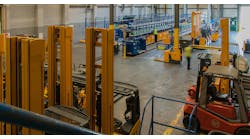Good news is an oxymoron, they say. Bad news, they say, is redundant. Well, I just got some good news and I'm guessing that it suggests a lot more good news. Let's see what you think.
What about the 3 million jobs we lost to factory floors in China and other places? The economy is recovering? Well, why isn't the stock market shooting up? Gas prices! How high will they go? What about Iraq and Afghanistan? Seems the sky is still falling.
With all that negative spin, the news does sound like Chicken Little. All the news is grim, tragic and pessimistic. The economy is recovering? Can't prove it by me. Well, let me try. Here are the latest numbers from an industry that is small but more bellwether that any other.
U.S. machine tool consumption was up more than 60 percent in March from February. The numbers were also up from last year's March by more than 56 percent. Now, admittedly, these increases come after a truly lousy two years since the dot-com bust of mid-2001. Such big-ticket sales numbers, however, have always preceded a classical recovery in industry in general. In fact, it may be the beginning of some phenomenally good years in American manufacturing.
All our "fundamentals," such as inflation rates, labor rates and availability, productivity rates (in all economic sectors), are up. Consumer confidence is healthy and quality levels are at engineering peaks. There is also the rapidly increasing cost of shipping raw material overseas, especially to China.
"As these market forces converge, they will create an upheaval in the manufacturing sector," says John B. Byrd III, president of the Association for Manufacturing Technology (AMT), McLean, Virginia. The result of which, he adds, "will be a boom in the North American manufacturing sector unlike anything we've seen in the last quarter century."
Ironically, Byrd's predictions are based upon China's continuing growth and expansion into the modern consumer world. The Chinese will, for example, be buying some 10 million cars a year in eight years. They already produce more steel than we do and their economy has been growing at an incredible 10 percent to 20 percent annually for decades.
While some Americans aren't all that thrilled with China's economy, Byrd and others note that there's outsourcing and there's insourcing. Numerous jobs in America are matters of foreign direct investment or suppliers to foreign companies.
If Byrd is right, and I for one think he's right on, then a lot of those guys and gals who are presently unhappy with an increasingly muscular global economy will be singing Chinese folk songs in a few months.
So much for Chicken Little, but then there's Pollyanna. Both are always wrong in their extreme views. I'm not suggesting that the same 3 million jobs are going to sail back to American factories across the Pacific Ocean. I do say that unemployment will decrease significantly as the year goes on and -- more to the point -- our economy, as always, will create millions of new jobs, many of them connected to production, that never existed before.
Much of that increase in activity and creativity will be found in the material handling industry as well. Many have noted that material handling is one of the last productivity and creativity frontiers in the factory world. In fact, the needs for manufacturing to increase parts movement, transfer and assembly in a modern plant will give the material handling engineers their greatest challenges in more than 25 years. A machining center's productivity today is limited only by the material handling sophistication on either side of it.
Chicken Little is always saying the sky is falling. Indeed, parts of it always look that way, but other parts are bluer than ever in terms of American manufacturing. The fundamentals have been terrific for months. The machine tool industry says manufacturing management is buying capital goods again -- in a big way.
Finally, the Fed has been making signals that it will raise interest rates in a few months. That all sounds like preparation for a party to me. Does that sound like Pollyanna? Or are you still listening to Chicken Little?
George Weimer, contributing editor


